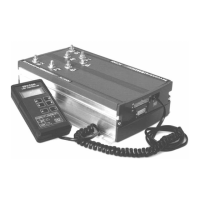22
nd
October 2004 SC2000 Manual – 177/52301 Rev G Page 41
14 EMC GUIDELINES.
The following guidelines are intended to help vehicle manufacturers to meet the requirements
of the EC directive 89/336/EEC for Electromagnetic Compatibility.
Any high speed switch is capable of generating harmonics at frequencies that are many
multiples of its basic operating frequency. It is the objective of a good installation to contain or
absorb the resultant emissions.
All wiring is capable of acting as a receiving or transmitting antenna. Wiring should be
arranged to take maximum advantage of the structural metal work inherent in most vehicles.
Vehicle metalwork should be electrically linked with conductive braids.
14.1 POWER CABLES
All cables should be routed within the vehicle framework and kept as low in the structure as is
practical - a cable run within a main chassis member is better screened from the environment
than one routed through or adjacent to an overhead guard.
Power cables should be kept short to minimise emitting and receiving surfaces
Shielding by the structure may not always be sufficient - cables run through metal shrouds
may be required to contain emissions.
Parallel runs of cables in common circuits can serve to cancel emissions - the battery positive
and negative cables following similar paths is an example.
Tie all cables into a fixed layout and do not deviate from the approved layout in production
vehicles. A re-routed battery cable could negate any approvals obtained.
14.2 SIGNAL CABLES
All wiring harnesses should be kept short.
Wiring should be routed close to vehicle metalwork.
All signal wires should be kept clear of power cables or made from screened cable
Control wiring should be kept clear of power cables when it carries analogue information - for
example, accelerator wiring.
Tie all wiring securely and ensure wiring always follows the same layout.
14.3 CONTROLLER
Thermal and EMC (emissive) requirements tend to be in opposition.
Additional insulation between the controller assembly and the vehicle frame work reduce
capacitive coupling and hence emissions but tend to reduce thermal ratings. A working
balance needs to be established by experiment.
The complete installation should be documented, in detail, and faithfully reproduced on all
production vehicles. When making changes, consider their effect on compliance ahead of any
consideration of cost reduction or other “improvement”.

